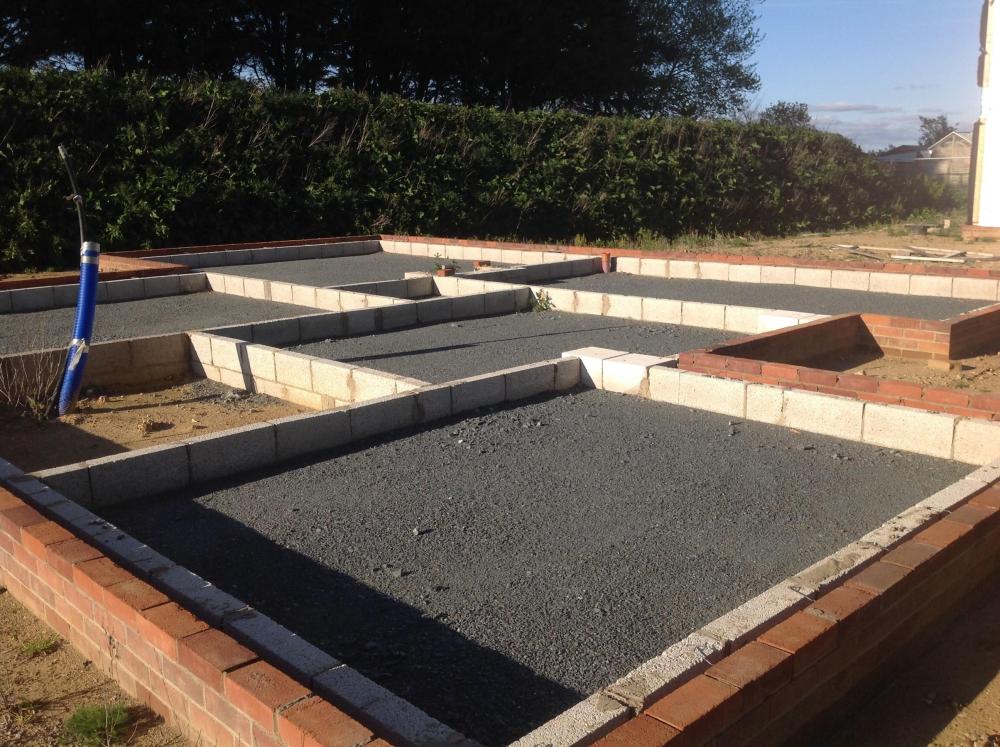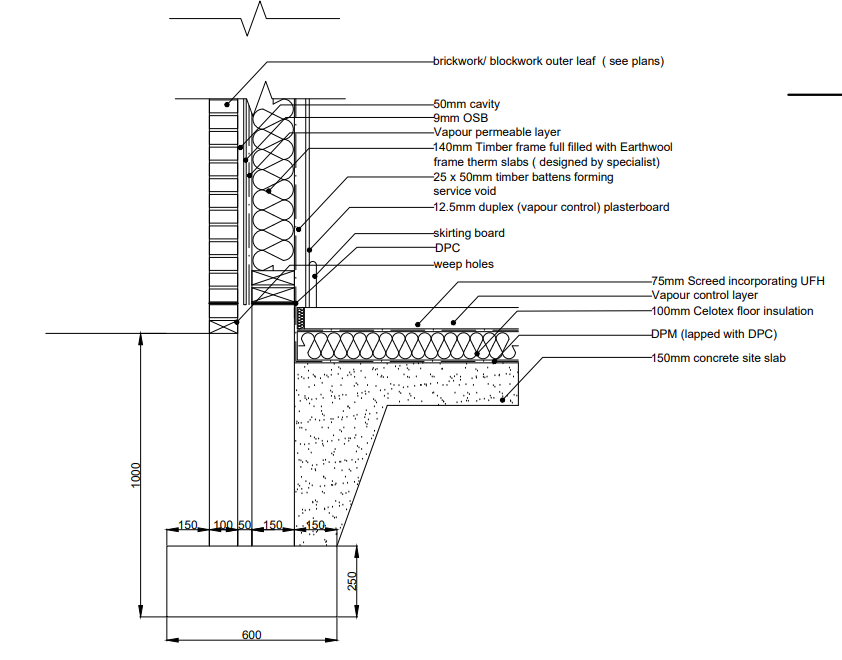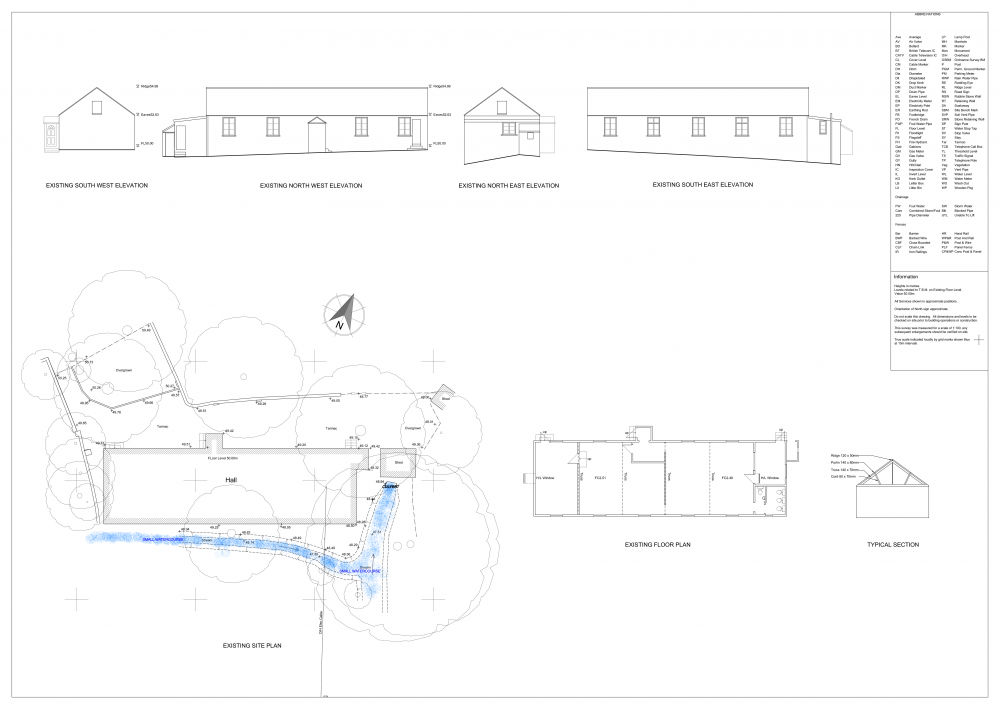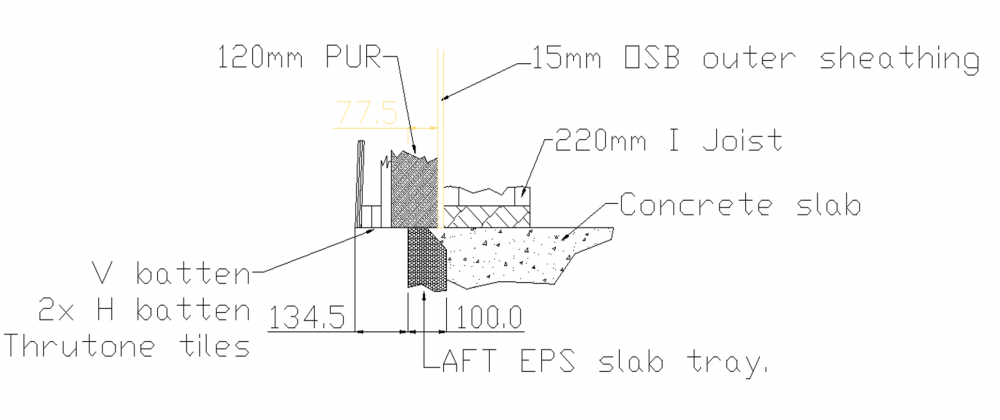Search the Community
Showing results for tags 'passive slab'.
-
There are some truly sophisticated UFH setups described here in this community. However, I have taken on board the wisdom of those who say that a passiv style house does not need such wizardry. My thermal blanket is a minimum 250mm on floor, walls and roof and I am tying the UFH pipes to the nominal 6mm mesh in the non-structural 175mm concrete slab. UFH is only on the ground floor and towel rails/shower mats will be electric-heated. (I've gratefully borrowed lots of your implementations!). As Wunda have got multiple thumbs up from you, I asked them to quote for the simplest solution (no actuators) of 1 zone and 5 loops of around 60m each. This is their quote: 1x 6 port manifold - £134.95+vat 1x Wilo pump station - £179.00 1x Isolation valves - £10.00+vat 3x 100m 16mm pert al pert pipe - £177.00+vat 1x Standard hardwire thermostat - £25.00+vat 1x Floor probe - £5.00+vat 1x Pallet Delivery - £30.00+vat Total including vat = £673.14 I'm very pleased with both the price and the speed of their response. I'll fit the kit myself and ask my electrician to wire it in. I'm just wondering if you can see if any bits are missing off the list.
-
The site I've acquired has construction already started. The picture below shows the footings and blockwork/brickwork to DPM level (150mm above finished ground level). I wish to change the construction to timber frame and have been looking at how to get the best fabric first approach I can within the constraints already imposed. The section below shows what my neighbour who is building in timber frame has specified. I'm concerned that this isn't good enough with insufficient insulation in floor and walls and cold bridging potential. Would appreciate your suggestions on how to get close to Passivehaus standard from here without ripping up the entire building footprint.
-
We have a passive slab and are busy choosing tiles, approx 270 sq m and we would like them to be 120cm x 120cm and a couple of tile shops have said we will need an anti crack mat which I assume is a decoupling membrane. Our slab is generally 100mm thick apart from the load bearing areas and has steel reinforcement within the concrete. What I am asking is the mat a necessary item or a just an in case item in that if the concrete does crack then the tile will not crack? Not sure if this needs another thread but what have people done with expansion joints? I really do not like them and a tile supplier I spoke to last year said we would not need them but I see them all the time in large tiled areas in commercial buildings and it is another one of those do I or do I not fit them. TIA
- 9 replies
-
- anti fracture mat
- passive slab
-
(and 1 more)
Tagged with:
-
I've been back and forth on what foundations I would like to use on our plot and I am really keen on a passive insulated raft. I had originally liked the idea, but then went off it as assumed too expensive, then read more and believe it should theoretically should be cheaper/ less hassle but I have never quanitified this. Hence I am going do a cost vs benefit analysis to see what the actual costs are and from there assess the benefit. E.g it might still be more expensive, but if it means less labour and less delays then still works out better. Before I start did anyone else do this? and have any existing excel sheets or similar or input they want to add? My thoughts are it might be a higher upfront cost but it has to work out similar in costs by the time you factor in all the stages required to do a normal type strip foundation with ground bearing slab and then adding insulation, membrane, UFH, screed etc. I understand every house and site will be different, and ground conditions will have a factor, But I have a pretty large open plot, lots of space to store muck and use later on, it is pretty much flat and there are no major trees or any ground issues which are currently known and it would seem unlikely there is anything going to come out of left field and surprise me.
-
Hard hat on. It is possible to run MVHR ducting through a passive slab? I am starting to think about ducting runs from my bungalow with vaulted ceilings. As a bungalow, there are no joists to take the runs. Passive slab not poured for another few months at least.
- 9 replies
-
- mvhr
- passive slab
-
(and 1 more)
Tagged with:
-
I know this has been discussed at some point, but it was on a very tiny slope and I have found nothing about anyone trying near a Watercourse or similar. So my question is: Is it possible under any circumstances to build Passive Slab on a slope of ca. 1.5 meters next to a Watercourse. My guess is "No" But i still think it s worth a try, as this would be a good slab solution. Here is some measurements (see Pic below) . House will be on a slope of 1.5 meters over 21 meters distance. But the bigger problem probably is the Watercourse directly next to it - oh, and I forgot- a few trees as well. I will ask Structural Engineer the same question, but her solution so far is not really a cheap one (Pile and Beam with slab , first quote coming is : 47000£+VAT ? ?) Thinking by now that it might be best to leave concrete out and just put suspended Timber Floor on Screwpiles. Anyone in here got experience with this? Even Though Helical Piles are not cheap, might still end up much cheaper. Has anyboday ever tried installing helical Piles themselves ? I just had a quote for the Piles themselves - just material - 1600mm length excl. shipping for 15USD each (100/pallet) , seems cheap enough to me ?
- 8 replies
-
- passivhaus
- passive slab
-
(and 3 more)
Tagged with:
-
I have spent the best part of the last two weeks putting down the type 1 for our slab, 150mm thickness in three layers, 59T in total over 127m2. It's done now but just walking on it you get a good impression of how solid it is. It set me wondering. I weight about 100kg, I am 6'4", my site boots have a ground area of 0.0225m2. Our building will weigh in at around 70T so across the whole slab that's about 583kg/m2 while I put much more that down on the area of my foot, about 4000kg/m2. This slab is not going to move anywhere. Is that overkill or what.
-
Im just planning how and where my soil pipes are going to poke up through my slab and I'm wondering what others have done for their 50mm waste connections. Always keen to save space and as I know where everything will go could I just have 50mm wastes poking up for every appliance and sink? If I use a strap boss from the soil pipe underground is this a bit stupid if it ever fails? Seems like it might have less chance of failure down there than surviving being beaten around by rebar and concrete. Either way can I get 50mm elbow into ducting? or is there no point even ducting the horizontals as the only wiggle room required will be horizontal..
- 5 replies
-
- passive slab
- raft
-
(and 1 more)
Tagged with:
-
Been working hard on the plans now we have had the all clear from BC, managed to get the stair design put back otherwise we are good to go. In drawing things up I came across the build up below from the architect. Its only on a portion of the front and rear walls (the others are 300mm I joist and 40mm PUR) but I am worried about several things and though I might seek thoughts from THE forum. My concerns are: 1. How to seal the bottom of the PUR to the top of the EPS to ensure no cold bridging? 2. What methods are there, other than long nails, to fix the Vertical battens through the PUR to the I joists (which only have 36mm thick flanges) and will these support the weight of tiles, horizontal battens and fixings. (I had thought of M12 studs fixed to the flanges -bolted both sides, and then fed through the PUR at intervals but it feels like a phaff although it won't be much of a cold bridge overall it feels like a great dew point opportunity. 3. What sort of thing (detail) can I do along the bottom of the overhang to make it look good, seal the bottom from insects but allow air flow up behind the tiles? Any thoughts greatly appreciated.
-
- cold bridge
- passive slab
-
(and 2 more)
Tagged with:
-
I would like a raft on eps foundation for all the thermal performance reasons. Our semi detached cottage will be demolished (planning permission permitting) leaving the front facade only and of course the party wall. Can anyone foresee any problems with this scenario? Can the same perimeter insulation blocks be used internally against the party and front wall? There will be a significant thermal bridge at these walls (even though the front wall will have EWI) is a passive slab even worth the expense...
-
Still negotiating on a plot... but I'd like to get my head around current construction methods and detailing. So in it's most basic form the plan is for a single story flat roofed bungalow, but where the land slopes away having an undercoft (ie partially dug into the hillside) with two bedrooms and a bathroom. What I'm looking for is some useful, guide/website/book that shows the foundation/slab/retaining wall/insulation/damp proofing interconnections including those tricky transitions at the sides between the buried structure and the visible outer skin. At the moment, for the main portion of the house I'm looking at passive slab, structural block walls with external insulation and rainscreen cladding and a beam/block or cast in situ inverted warm roof. Height is key aspect of the planning - so minimising structure and maximising internal height is key. Suggestions, guidance, criticisms, examples please. Thanks Dee
- 21 replies
-
- undercroft
- retaining wall
-
(and 1 more)
Tagged with:
-
I have put a time lapse of the whole passive slab installation on my blog http://www.passivehouseselfbuild.co.uk/passive-slab-foundation/ For anyone considering this type of foundation but don't know exactly whats involved it gives a pretty clear indication of how it is done. I have had comments from every other trade on site about the quality of the power floated finish, so well done to the MBC team.
-
Hi, I have been investigating building a house with ICF and now looking at how to run the pipes for the plumbing. The house will be all one one level around 250 sqm with 3-4 bathrooms and separate utility room. Also sink in kitchen will be on an island. I am planning on putting in UFH pipes (for potentially cooling the house). I know that it's normal for the waste and UFH pipes to be in the slab, is it also ok to put the hot and cold water pipes in the slab? I ask this as I think it would be easier to do it this way rather than cut chases into the ICF internal foam. Thanks in advance for any help
- 12 replies
-
- icf
- passive slab
-
(and 1 more)
Tagged with:








